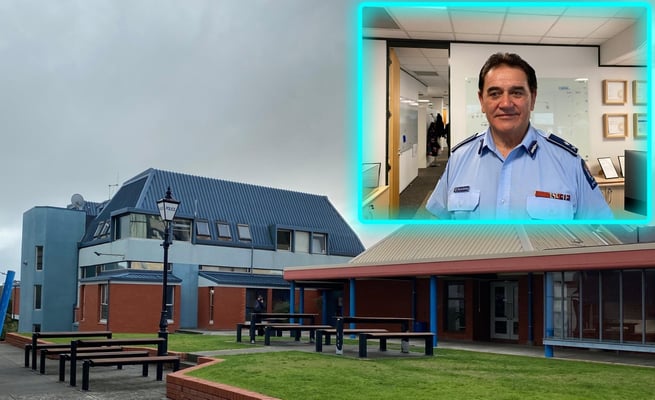Diversity, inclusiveness, empathy at heart of NZ’s policing

Ensconced in a picturesque valley in Porirua, a short drive from the Wellington CBD, the Royal New Zealand Police Training College is the premier institution where NZ’s police force is trained.
Training imparted at the college is for all levels of the police force, with just 20 percent of all training being for new recruits, though there is a common misconception that the college exists only for recruit training. Face-to-face training is conducted for new recruits and increasingly, e-learning and blended learning approaches are used to train staff in other locations and those on deployments overseas.
For new recruits, the skills taught are wide ranging –from physical fitness and physically and tactically dealing with offenders in contact situations to learning about legislation, offences and preparedness for fast-unfolding scene-of-crime situations. Developing mental alertness, toughness, quick reflexes, and multitasking is also an important part of the training.
Sprawled across 17 hectares, the campus comprises several buildings housing lecture theatres, large indoor gym-like facilities, training fields, skid tracks for driver training, a shooting range, dining halls that serve up 1300 hot meals daily, accommodation blocks with some 459 beds and several other facilities. There is also a police museum that is open to the public.
The college has had to scale up in recent times, with the induction of 1800 new police recruits to the force since 2017. The new recruit training lasts sixteen weeks and the selection process before being recruited is stringent. Candidates are carefully selected so that those recruited complete their training successfully and join the force at the end of it.
Increasingly diverse force
The NZ police force employs 14,500 staff, both sworn and non-sworn. Of these 11,500 are uniformed, spread across 12 districts across the country, with three in the larger Auckland urban region alone.
Growing ethnic diversity in the police force reflects New Zealand’s increasingly diverse population. In 2017, excluding Pacific Island and Maori, the percentage of ethnic peoples was 3.7 percent. In a matter of just five years, that has nearly doubled to 7 percent.
“We've put in a lot of hard work over the years to shift the cultural paradigm of this organisation and I'm absolutely proud of what we've built,” says Deputy Commissioner Wallace Haumaha. Increasing ethnic diversity in the force has helped the police to work closely with a growing range of communities.
“We would be one of the leading jurisdictions around working inside of indigenous communities right across the board,” Haumaha said. “I'm proud to say in all my travels across Southeast Asia, Europe, Australia that I have been privileged to see a lot of indigenous and cultural communities and I have to say that it has reaffirmed the position that we in in this country are world leaders. We still have a long way to go but our diversity strategy inside of this organisation has been second to none.”
 The Deputy Commissioner commended National Ethnic Partnerships Manager Rakesh Naidoo for his work in bringing in diversity into the force. “Rakesh has introduced into the organisation the ability for these people to come in and bring with them their religious backgrounds – some of our India police officers wear their traditional dress, we’ve established a little multi-faith prayer room for staff from different religious backgrounds who want to pray... Those things would have been unheard of in police stations across the globe.”
The Deputy Commissioner commended National Ethnic Partnerships Manager Rakesh Naidoo for his work in bringing in diversity into the force. “Rakesh has introduced into the organisation the ability for these people to come in and bring with them their religious backgrounds – some of our India police officers wear their traditional dress, we’ve established a little multi-faith prayer room for staff from different religious backgrounds who want to pray... Those things would have been unheard of in police stations across the globe.”
Haumaha was also appreciative of the Commissioner’s Ethnic Forum, whose members were also present with the ethnic media representatives during the visit led by NZ Police Ethnic Responsiveness Manager, Auckland based Jessica Phuang.

“We’re very fortunate in this country for our inclusiveness and diversity and when I hear the rhetoric and the banter saying that this organisation is soft on crime ––you couldn't be any further from the truth,” Haumaha said.
Burglaries, ram raids, gangs
Addressing the recent spate of gangland shootings, burglaries and ram raids, the Deputy Commissioner said that as well as policing, there was need to approach these issues from other important angles like the socio-economic situation.
“So what does prevention look like? Is it about building bollards outside of every convenience store and dairy across the country – or is it about trying to change the mindset or get inside those desperate homes and work with those families that are suffering economically?” Haumaha said.
With some sections of society left in long term, cyclical poverty and bereft of options, young people faced with empty kitchen cabinets in their homes feel forced to commit crimes. “So, how do we collectively come together – if you understand that a sector of our community who contribute to all the crime issues are part of the problem that we're trying to address?” he asked.
When Indian Weekender asked if the police had the support of the government on all fronts, Haumaha said, “Absolutely.” Do we need legislative changes to make policing more effective? “Absolutely,” he said again adding that the Commissioner was in talks with the government on these exact matters “as we speak.”
Haumaha fronted TVNZ’s Breakfast show on the same day saying that the NZ Police had the complete support of the police minister but when asked if (now former) minister Poto Williams was up to it, he said that was a matter for the government to answer. In less than a week, Williams has been replaced by Chris Hipkins.
Police media team

The visiting ethnic media representatives also had the opportunity to drop in on the New Zealand Police National Headquarters and briefly look at the control room – the high-tech nerve centre of the nation’s police activity.
The police media centre is a 6am-to-11pm operation in Wellington with some ten team members rostered across the workday. Two of the team – Jarred Williamson and Stephanie McKay – and Media Relations Director Julie Clausen spent an hour-and-a-half speaking to the visiting ethnic media members.
The team fields more than 200 media queries on a good day. At Indian Weekender’s request the media team explained the detailed process and stages between the reported crime, the writing and distribution of the news release. Court reporting protocols are strictly adhered to while drafting and putting out news releases, but there is little that can be done with social media often jumping the gun and spilling out details before the official word is out.
Processing reports as they come in and develop and putting out news releases is not the only role that the media unit plays. It also assists with Official Information Act requests and coordinates activities with other media (advertising), public relations and communications across the organization.
The police media unit works in sync with the control room and is situated there – at the coalface of developing situations nationwide.

Ensconced in a picturesque valley in Porirua, a short drive from the Wellington CBD, the Royal New Zealand Police Training College is the premier institution where NZ’s police force is trained.
Training imparted at the college is for all levels of the police force, with just 20 percent of all...
Ensconced in a picturesque valley in Porirua, a short drive from the Wellington CBD, the Royal New Zealand Police Training College is the premier institution where NZ’s police force is trained.
Training imparted at the college is for all levels of the police force, with just 20 percent of all training being for new recruits, though there is a common misconception that the college exists only for recruit training. Face-to-face training is conducted for new recruits and increasingly, e-learning and blended learning approaches are used to train staff in other locations and those on deployments overseas.
For new recruits, the skills taught are wide ranging –from physical fitness and physically and tactically dealing with offenders in contact situations to learning about legislation, offences and preparedness for fast-unfolding scene-of-crime situations. Developing mental alertness, toughness, quick reflexes, and multitasking is also an important part of the training.
Sprawled across 17 hectares, the campus comprises several buildings housing lecture theatres, large indoor gym-like facilities, training fields, skid tracks for driver training, a shooting range, dining halls that serve up 1300 hot meals daily, accommodation blocks with some 459 beds and several other facilities. There is also a police museum that is open to the public.
The college has had to scale up in recent times, with the induction of 1800 new police recruits to the force since 2017. The new recruit training lasts sixteen weeks and the selection process before being recruited is stringent. Candidates are carefully selected so that those recruited complete their training successfully and join the force at the end of it.
Increasingly diverse force
The NZ police force employs 14,500 staff, both sworn and non-sworn. Of these 11,500 are uniformed, spread across 12 districts across the country, with three in the larger Auckland urban region alone.
Growing ethnic diversity in the police force reflects New Zealand’s increasingly diverse population. In 2017, excluding Pacific Island and Maori, the percentage of ethnic peoples was 3.7 percent. In a matter of just five years, that has nearly doubled to 7 percent.
“We've put in a lot of hard work over the years to shift the cultural paradigm of this organisation and I'm absolutely proud of what we've built,” says Deputy Commissioner Wallace Haumaha. Increasing ethnic diversity in the force has helped the police to work closely with a growing range of communities.
“We would be one of the leading jurisdictions around working inside of indigenous communities right across the board,” Haumaha said. “I'm proud to say in all my travels across Southeast Asia, Europe, Australia that I have been privileged to see a lot of indigenous and cultural communities and I have to say that it has reaffirmed the position that we in in this country are world leaders. We still have a long way to go but our diversity strategy inside of this organisation has been second to none.”
 The Deputy Commissioner commended National Ethnic Partnerships Manager Rakesh Naidoo for his work in bringing in diversity into the force. “Rakesh has introduced into the organisation the ability for these people to come in and bring with them their religious backgrounds – some of our India police officers wear their traditional dress, we’ve established a little multi-faith prayer room for staff from different religious backgrounds who want to pray... Those things would have been unheard of in police stations across the globe.”
The Deputy Commissioner commended National Ethnic Partnerships Manager Rakesh Naidoo for his work in bringing in diversity into the force. “Rakesh has introduced into the organisation the ability for these people to come in and bring with them their religious backgrounds – some of our India police officers wear their traditional dress, we’ve established a little multi-faith prayer room for staff from different religious backgrounds who want to pray... Those things would have been unheard of in police stations across the globe.”
Haumaha was also appreciative of the Commissioner’s Ethnic Forum, whose members were also present with the ethnic media representatives during the visit led by NZ Police Ethnic Responsiveness Manager, Auckland based Jessica Phuang.

“We’re very fortunate in this country for our inclusiveness and diversity and when I hear the rhetoric and the banter saying that this organisation is soft on crime ––you couldn't be any further from the truth,” Haumaha said.
Burglaries, ram raids, gangs
Addressing the recent spate of gangland shootings, burglaries and ram raids, the Deputy Commissioner said that as well as policing, there was need to approach these issues from other important angles like the socio-economic situation.
“So what does prevention look like? Is it about building bollards outside of every convenience store and dairy across the country – or is it about trying to change the mindset or get inside those desperate homes and work with those families that are suffering economically?” Haumaha said.
With some sections of society left in long term, cyclical poverty and bereft of options, young people faced with empty kitchen cabinets in their homes feel forced to commit crimes. “So, how do we collectively come together – if you understand that a sector of our community who contribute to all the crime issues are part of the problem that we're trying to address?” he asked.
When Indian Weekender asked if the police had the support of the government on all fronts, Haumaha said, “Absolutely.” Do we need legislative changes to make policing more effective? “Absolutely,” he said again adding that the Commissioner was in talks with the government on these exact matters “as we speak.”
Haumaha fronted TVNZ’s Breakfast show on the same day saying that the NZ Police had the complete support of the police minister but when asked if (now former) minister Poto Williams was up to it, he said that was a matter for the government to answer. In less than a week, Williams has been replaced by Chris Hipkins.
Police media team

The visiting ethnic media representatives also had the opportunity to drop in on the New Zealand Police National Headquarters and briefly look at the control room – the high-tech nerve centre of the nation’s police activity.
The police media centre is a 6am-to-11pm operation in Wellington with some ten team members rostered across the workday. Two of the team – Jarred Williamson and Stephanie McKay – and Media Relations Director Julie Clausen spent an hour-and-a-half speaking to the visiting ethnic media members.
The team fields more than 200 media queries on a good day. At Indian Weekender’s request the media team explained the detailed process and stages between the reported crime, the writing and distribution of the news release. Court reporting protocols are strictly adhered to while drafting and putting out news releases, but there is little that can be done with social media often jumping the gun and spilling out details before the official word is out.
Processing reports as they come in and develop and putting out news releases is not the only role that the media unit plays. It also assists with Official Information Act requests and coordinates activities with other media (advertising), public relations and communications across the organization.
The police media unit works in sync with the control room and is situated there – at the coalface of developing situations nationwide.










Leave a Comment